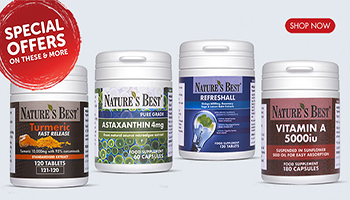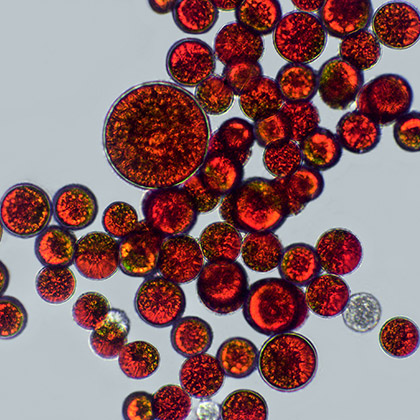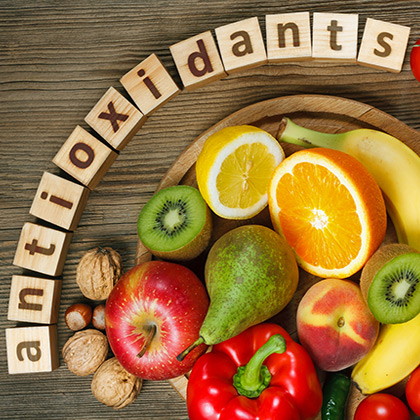
Flavonoids – also called bioflavonoids – are a group of powerful antioxidants derived from plants. Scientists find them particularly interesting because it’s believed that their antioxidant properties can help to protect against harmful chemicals made in the body called free radicals. Antioxidants like flavonoids are also thought to be important for your vision, with the American Optometric Association suggesting that adding antioxidants to your diet can improve your eye health.i However, despite these claims, there is still conflicting information on the reliability of these powerful antioxidants.ii To provide some clarity, we’ve broken down research into flavonoids and their potential benefits on eye health.
How is vision related to nutrition?
A healthy diet can help prevent the development of certain eye conditions, although the link between nutrition and vision health isn’t as strong as it is for other conditions such as heart diseaseiii.
If you want to stay healthy in general, it’s essential to eat healthily too. This means basing your diet on starchy foods such as pasta, rice, bread and potatoes, with lots of fruit and vegetables (at least five portions every day), foods rich in protein, some milk and dairy and limited amounts of fat, salt and sugar.
Since a balanced diet can help keep you healthy in general, there’s every reason to believe it could help keep your eyes healthy too. However some eye conditions are thought to be more affected by what you eat than others, including:
- Diabetic retinopathy (a condition linked with having diabetes)
- Age-related macular degeneration (AMD)
- Cataracts
- Dry eye
- Retinitis pigmentosa (a group of inherited eye disorders that affect the retina at the back of the eye)
What are the different types of flavonoid?
There are thousands of known varieties of flavonoids – they’re thought to be the largest group of plant chemicals. Flavonoids are also sometimes called vitamin P, but they aren’t technically vitamins because vitamins are essential compounds for human health, and as far as we know, not all flavonoids are essential. However, that does not mean that they aren’t extremely beneficial. They fall into different groups, including:
-
Flavonols
-
Flavones
-
Flavanones
-
Anthocyanins
-
Catechins
-
Isoflavones
Since flavonoids are found in almost all fruits and vegetables, scientists believe that this might be some of the reason why a diet rich in fruit and veg is essential for good health. Several specific flavonoids have also been studied for their potential health benefits. Quercetin, for example, is a type of flavonol that has been much investigated for its role in reducing allergies; resveratrol has been examined for its ability to reduce the risk of heart disease; and hesperidin for its anti-inflammatory properties. For more information on this, see our guide to antioxidants and eye health.
Are flavonoids and bioflavonoids the same?
Flavonoids and bioflavonoids are very similar – they’re found in the same foods, they’re both water soluble and have similar properties and effects on the human body – but they have a different molecular structure. That said, for most intents and purposes, the use of the terms flavonoid and bioflavonoid is interchangeable.

Which flavonoids help to improve eye health?
Experts have conducted research into a number flavonoids thought to improve eye health. These range from nutrients in everyday food, to more obscure ones that you may need to consume through supplementation.
Anthocyanins and anthocyanidins
Anthocyanins and anthocyanidins are flavonoids responsible for the blue, purple and red pigments of many plants. Many believe they may support small blood vessel health by repairing damaged collagen in blood vessel walls and capillaries – including those in the eyes. In the past decade, however, a number of studies have been conducted into anthocyanins and anthocyanidins and their relationship to eye function. One particular piece of research suggests that anthocyanins may help prevent damage to the eye caused by diabetes, a condition called diabetic retinopathy.v More recently, one study found that anthocyanins in blueberries may inhibit the start and progression of AMD by way of their antioxidant capabilities.vi
Anthocyanins and anthocyanidins can be found in a range of blue, purple and red fruits, including blueberries, bilberries, grapes, currants and aubergine. However, if you find it difficult to consume the right amount through diet alone, it might be a good choice to consider supplementation. Our high-quality Colladeen® Original supplements contain a powerful amount of anthocyanidins to help support eye health.
Quercetin
Belonging to the flavonol group of flavonoids, quercetin is often used in nutritional supplements to help relieve the symptoms of allergies such as hay fever. But they may also play a part in protecting against the development of AMD. In one study, quercetin – along with a number of other flavonoids– was found to protect human retinal pigment epithelial (RPE) cells from damage, reducing the overall risk of developing AMD.vii However, more clinical trials on humans is required to confirm these results. If you’re looking to boost your quercetin intake, our high-quality Quercetin 500mg might be a good place to start.
Vitamin C
While vitamin C isn’t a flavonoid as such, but most foods that contain vitamin C also contain flavonoids. in fact, the two are thought to work together in the body to support a range of conditions. Vitamin C is essential for forming and maintaining collagen, including the collagen found in the cornea, the transparent front part of the eye. It’s also important for keeping your blood vessels healthy, which also includes the blood vessels in your eyes. According to the American Optometric Association, studies suggest vitamin C may lower the risk of developing cataracts – one of the most common causes of vision loss – as well as an eye condition called age-related macular degeneration (AMD).i In one European study, researchers found those with the highest blood levels of vitamin C were 64 per cent less likely to develop cataracts than those eating fewer vitamin C-rich foods.iv Additionally, more recently researchers writing in the American Journal of Clinical Nutrition discovered people who regularly eat oranges – which are arguably the best-known source of vitamin C and flavonoids – are less likely to develop AMD in later life.iv According to the researchers, it was the flavonoids in oranges that appeared to provide the protective effect.
Flavonoid-rich foods for eyesight support
lavonoids are widely-available in a large range of foods – including many fruits and vegetables – such as:
-
Apples and bananas
-
Strawberries, blackberries and blueberries
-
Oranges, lemons and grapefruit
-
Tomatoes, peppers and chillies
-
Kale, watercress and broccoli
-
Sweet potatoes and onions
-
Cocoa, tea and red wine
-
Pistachios and pecans
-
Cinnamon
-
Soya beans and tofu
Ways to consume more flavonoids
Flavonoids are widely-available in a range of fruits and vegetables, including; apples, bananas, strawberries, tomatoes, peppers, chillies, kale, sweet potatoes, watermelons cocoa, and quinoa. There is currently no recommended daily intake for flavonoids, although experts recommend getting your flavonoids from as many different food sources as possible, rather than just a few of the same foods every day. This means you’ll be getting a wide range of the many different types of flavonoids in your diet.
Cooking and storing can reduce the level of flavonoids in food, however, so if you’re getting yours through your diet rather than in a supplement, try to eat flavonoid-rich foods raw whenever you can, and make sure they’re as fresh as possible. Once a fruit or vegetable begins losing its colour, it also starts to lose its flavonoid content. As a way of increasing the number of flavonoids you consume through diet, one really simple way would be to add a handful of fresh or dried mixed berries to your cereal in the morning. We’d recommend a sprinkling of dried cranberries, for a boost of vitamin C and anthocyanidins. Meanwhile, you can also top up your flavonoid levels by taking a supplement that contains specific eye-healthy ingredients – try one that contains vitamin C with flavonoids, anthocyanidins or quercetin.
No doubt there are promising results from the effects of flavonoids in improving eye health. For more information on a range of common eye conditions, as well as advice on how to improve your overall eye health, feel free to visit our Vision Health Hub.
References:
-
American Optometric Association. Diet and Nutrition. (2018). Available online: https://www.aoa.org/patients-and-public/caring-for-your-vision/diet-and-nutrition
-
Milbury, P.E. Flavonoid intake and eye health. J Nutr Gerontol Geriatr. (2012). ;31(3):254-68. Available online: https://www.ncbi.nlm.nih.gov/pubmed/22888841
-
Available online: https://www.rnib.org.uk/eye-health/looking-after-your-eyes/nutrition-and-eye
-
Gopinath, B, et al. Dietary flavonoids and the prevalence and 15-y incidence of age-related macular degeneration. Am J Clin Nutr. (2018 Aug 1) ;108(2):381-387. Available online: https://www.ncbi.nlm.nih.gov/pubmed/?term=Dietary+flavonoids+and+the+prevalence+and+15-y+incidence+of+age-related+macular+degeneration
-
Scharrer, A., Ober, M. Anthocyanosides in the treatment of retinopathies. Klin Monatsbl Augenheilkd. (1981) ;1178:386-389. Available online: https://europepmc.org/abstract/med/7253530
-
Huang, W.Y., et al. Protective Effects of Blueberry Anthocyanins against H2O2-Induced Oxidative Injuries in Human Retinal Pigment Epithelial Cells. J Agric Food Chem. (2018 Feb 21) ;66(7):1638-1648.
-
Hanneken, A., et al. Flavonoids protect human retinal pigment epithelial cells from oxidative stress-induced death. Inv Ophthalmol Vis Sci. (2006) ;47:3164-77.
Related Posts?
Disclaimer: The information presented by Nature's Best is for informational purposes only. It is based on scientific studies (human, animal, or in vitro), clinical experience, or traditional usage as cited in each article. The results reported may not necessarily occur in all individuals. Self-treatment is not recommended for life-threatening conditions that require medical treatment under a doctor's care. For many of the conditions discussed, treatment with prescription or over the counter medication is also available. Consult your doctor, practitioner, and/or pharmacist for any health problem and before using any supplements or before making any changes in prescribed medications.

Christine
Christine Morgan has been a freelance health and wellbeing journalist for almost 20 years, having written for numerous publications including the Daily Mirror, S Magazine, Top Sante, Healthy, Woman & Home, Zest, Allergy, Healthy Times and Pregnancy & Birth; she has also edited several titles such as Women’ Health, Shine’s Real Health & Beauty and All About Health.
View More



